How To Choose the Perfect Wetsuit
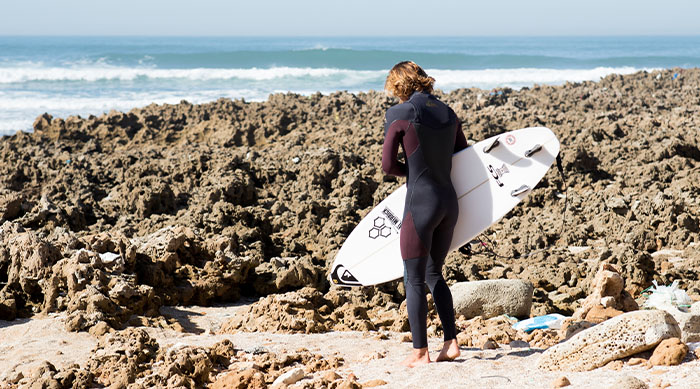
Buying a new wetsuit can be quite a challenge. There are several styles to pick from, and each of those styles have variations from the other. Choosing the right wetsuit is essential to making sure you can maximise your time in the surf. When buying a new wetsuit some factors, you’ll need to take into consideration, include type, fit, thickness, zip entry, neoprene and usage. To help make things a little easier we’ll cover each of these in detail in this wetsuit guide.
What Are the Different Types of Wetsuits?
There’s several factors to take into consideration when researching your new wetsuit purchase and adding to that is the number of different wetsuits that are designed for different weather conditions, water temperatures and preferences. For example, a wetsuit temperature guide for Victoria would suggest as 4/3 in the middle of winter (with boots!) and 3/2 steamer or short arm steamer in summer. Lets dig into the different types of wetsuits that are available:
Steamers: For cool to super cold water.
The steamer is the classic wetsuit look with full body coverage over your legs and arms, which can also be known as full suits. Steamers can feature built in hoods for the extra cold days in places like Victoria or Tasmania, or allow for more mobility with short cut arms and full legs that are better suited for warmer regions like Queensland.
Spring Suit: For the changing seasons.
Perfect for slightly warner water, but still a little brisk and too cold for boardshorts. Springsuits generally have above the elbow and above the knee coverage Long arms and short leg spring suits are also quite popular for warm water/cold air locations.
The Short John: Suns out, guns out.
The Short John wetsuit option takes the spring suit style and trims it down with a tank-style, sleeveless design (like a singlet top). Generally seen with a short leg (above knee) cut, you can get some with long leg coverage for extra warmth that still allows a high level of arm mobility for paddling. These suits allow for a very high level of paddle mobility whilst maintaining warmth.
Wetsuit Tops and Vests: When boardies aren’t enough.
Vests are a great addition to your board short program when surfing in summer to keep off any wind chill. Available in either short arm, long arm or sleeveless options with pullover or zippered access.
How Should A Wetsuit Fit
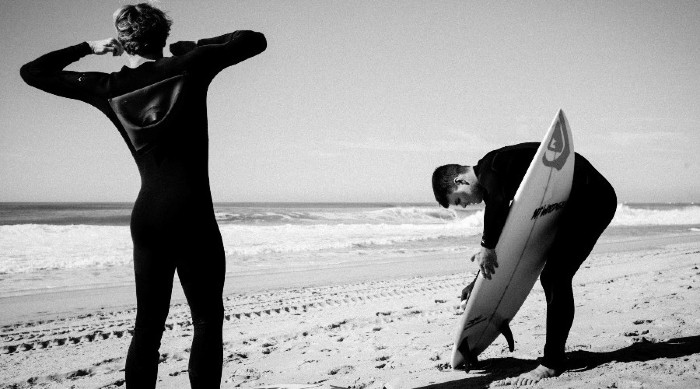
When buying a new wetsuit, it’s critically important in making sure the fit is right. If your wetsuit is too big it will chafe and fill with water, leaving you cold and weighed down. If your suit is too tight, you’ll lose mobility, leaving you feeling exhausted in the water as well as wasting valuable energy changing every time you surf.
Here are our top tips on how to pick the right size wetsuit:
- Height & Weight—Your height & weight are two of the most important factors to take into consideration when choosing your new wetsuit. Start with your current height and weight to get a ballpark idea of where you’ll land for wetsuit sizing.
- Chest Measurement—To find your chest measurement, measure the circumference of your chest at its widest point with a tape measure. Finding this point, start by positioning the tape measure under your armpits making sure the tape is snug and not too tight.
- Precision Measurements—To get a more snug and precise fit, repeat the measuring above steps on your neck, waist, hips, and inseam.
- Sizing—Wetsuit sizing follows the XS, S, M, L, XL convention with tall (T) and short (S) options for each size. For example a label with MT equals Medium Tall. To better help with getting as close to possible to your perfect fitting wetsuit refer to the size chart for the particular wetsuit you’re after. Also, if possible, try on wetsuits in different sizes as every brand (and some models) of wetsuits are different.
- Between Sizes?—If you happen to be between wetsuit sizes there’s still options for you to get that amazing fitting wetsuit. If you happen to have longer arms or legs, size up. If you happen to have shorter limbs, size down. Still unsure? Go with the larger size – it’s better to have more coverage on your arms and legs than not enough, plus, surfing in a wetsuit that’s too small becomes restrictive and tiresome very quickly.
How Thick Does Your Wetsuit Need To Be?
Wetsuit technology has come a long way in the short time they’ve been around. The first wetsuits were developed in the early 1950s and leaves any modern-day surfer wondering how the older generation survived. Different water temperatures generally give you an idea of the wetsuit thickness you need, However, personal preference and tolerance to the cold are factors you should always consider. The colder the water gets, the thicker the suit (the higher the number of millimeters of neoprene insulation - 3/2mm > 4/3mm > 5/4/3mm) you’ll need to make sure you stay warm.
Read our complete guide to wetsuit thickness here.
Wetsuit Zippers: Front, Back, or Zipperless?
Every wetsuits has an entry point/system to get in and out of, but there’s really only three types of entry - chest zip, back zip or zipperless. To make it super easy to remember, a chest zip has a horizontal orientation, a back zip has vertical orientation and a zipperless is just that, zipperless:
Front Zip
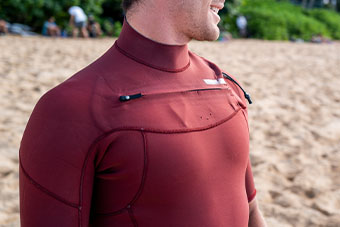
Chest (or front) zip wetsuits come in three options: 1 - Fully Detached where you’ll have to pull the top collar over your head to connect to the zipper and close the suit. Fully detached is the easier chest zip to get on/off. 2 - Open Chest Zip is where you have to connect the zipper together to close it, this allows for greater flexibility of the entry area when getting the wetsuit on/off 3 - Closed Chest Zip has the zip already attached and is the quickest option at zipping your wetsuit closed and getting in the water. It does increase the challenge of getting the suit on and off though. Something to think of if you have shoulder issues.
Back Zip
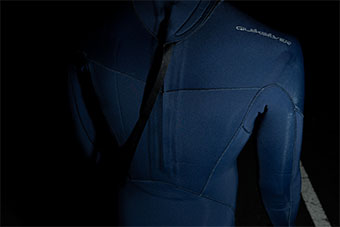
A back zip wetsuit is the more traditional zipper style for wetsuits, it’s where it all started. The back zip wetsuit has a vertical zip that runs from the base of your neck down to your lower back, and this style of wetsuit is a lot easier to get on and off compared to the chest zip style. Having a zipper on the back does leave you more prone to flushing when duck diving, or falling.
Zipperless
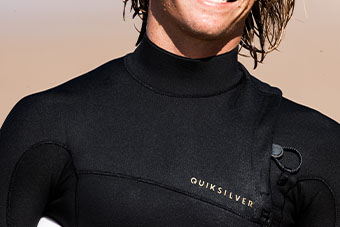
Zipperless suits are a relatively new innovation, firstly arriving on the scene around the late 1990’s/early 2000’s. This entry type decreases water flushing while increasing the overall mobility/flexibility of the wetsuit. However, zipperless wetsuits are the most difficult to get on and off, especially for beginners or people with shoulder issues. If a zipperless suit fits you like a second skin and you don’t mind a bit of work when getting changed, check out zipperless wetsuits.
Other Wetsuit Features To Look For:
The most important features are in the details. Wetsuits designed for surfing should include reinforcements in key areas like the knees, have arm and leg cuffs to minimise flushing or even thermal linings to increase warmth.
Knee Pads
The knees are one of the most worn areas on a wetsuit, so you want to make sure your wetsuit has reinforced knee pads with a thicker rubber or tough nylon material. This will extend the life of your suit and keep you in the water longer.
Arm and Leg Cuffs
Be sure to check the arm and leg openings for seals or beveled edges. These seals or beveled edges help to reduce flushing and improve the materials durability when changing.
Lining
Many neoprenes are lined with nylon to make the wetsuit easier to get on and off but warmer suits now feature an internal thermal lining. The lining, while helpful getting the suit on/off, also helps to insulate and retain your body heat longer. Some suits have thermal lining inside the entire suit, where other suits have lining only on the back and chest panels. Thermal lining increases warmth retention by trapping a thin layer of air against your skin which is then warmed by your body, leaving you comfortable in the water without affecting your range of movement.
Key Pocket
The Key Pocket is a dedicated area on your wetsuit that can securely hold a key (generally a car key) on your body while you’re surfing. This is done by creating a pocket on your wetsuit that holds the key by an elastic cord and is found around the knee, or in the chest entry area.
Wetsuit Material: Which Is Right for You?
Petroleum-based neoprene was the only option for decades, but now there are different types of neoprene to keep you warm while surfing. With major innovations in wetsuit materials recently have improved both the functionality and availability of more sustainable alternatives. The main two types used today are Limestone and Yulex Neoprenes.
Limestone Neoprene:
Made from limestone rock & free from almost all impurities, limestone neoprene tends to be lighter and absorbs less water, making it warmer and more flexible than many traditional neoprenes. It is also considered more sustainable than oil-based options as it not only lasts longer, limestone is less harmful to the environment than oil and petroleum based options.
Yulex Neoprene
Although costly, Yulex is completely rubber-free and considered one of the most sustainable wetsuit materials. For those who suffer from neoprene allergies, Yulex plant-based neoprene is a good hypoallergenic option. Yulex material is a natural rubber made from sustainably grown hevea trees, Earth’s main source of rubber. Not only is Yulex a hypoallergenic wetsuit material, but its creation process is significantly less damaging to the environment compared to that of Neoprene.
Wetsuit Paneling & Seams
Seams connect the different panels of neoprene together to create a wetsuit and play a critical role in the suits flexibility, warmth and durability. From flat lock stitching to glued and blind stitching (GBS) seams, performance seals like liquid glue and neoprene tape that help form a watertight closure on cold-water suits, we cover them all below.
Panels
Wetsuit, and in particular steamers, are made up of several panels stitched (or glued) together to create the overall silhouette, and often feature at least one panel (usually in the chest and back area) of smooth skin rubber. This smooth skin blocks wind and traps heat in critical areas of the body, but are more sensitive to cracking if left in direct sunlight. Whilst on the other end of the spectrum, lycra is generally reserved for swimming and triathlon suits, providing protection from the harsher elements of the sun and wind but minimal warmth.
Flatlock
The simplest type of stitching – flatlock seams – are found on rash vests and warm water suits like short johns and wetsuit vests. Two pieces of neoprene are connected at the ends by a stitch that runs through the neoprene. Flatlock seams are strong, durable and cost-effective but water passes freely through them and flexibility is limited.
Glued and Blind Stitched (GBS)
Glued and blind stitched (GBS) seams are a step above flatlock seams with improved warmth and flexibility. Panels are glued together up to two or even three times at the panel edges for a better seal, before being joined by a blind stitch. As a result, you’ll only see the seam on one side of the suit unless you find a seam with double-blind stitched where the process performed on either side of the neoprene. The reason it is called a blind stitch is because the needle doesn’t pass all the way through the neoprene by using a hooked needle. This method lets in less water and creates a more flexible, durable seal.
Taped
Taped seems are created by applying a thin neoprene tape on the inside of seam, they can either tape 100% of the suit or just in critical areas like arms and around the crotch. on the inside of the suit helps enhance durability while improving the watertight seal. Taped seams help enhance durability while improving the watertight seals, and are especially useful in seams that see a lot of stretch. You’ll only find tape applied to GBS seams, as it’s near impossible to tape a flat lock seam and keep the seal intact.
Liquid Taped
Liquid Taped seams provide the ultimate in warmth and performance by creating an entirely waterproof seal while adding minimal weight. A special liquid rubber compound material is applied to either the inside, outside, or both sides of the seam to create a durable, flexible, waterproof barrier. Sometimes called welded seams, liquid taped seals are found on higher-end performance suits and dedicated cold water wetsuits.
Choose Your Sport: Surfing Wetsuits Versus Swimming Wetsuits
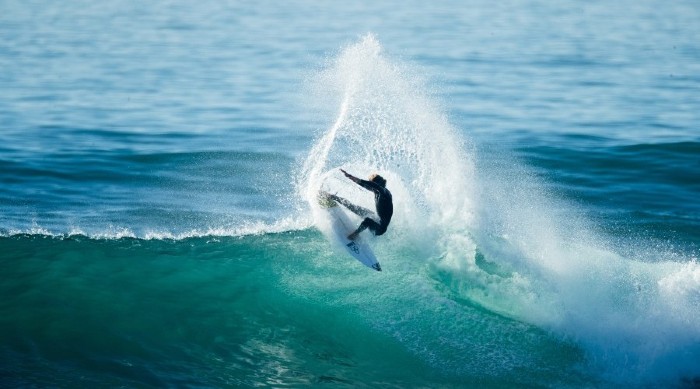
Any wetsuit will keep you warm in the water, but the choosing the right suit can make all the difference when the conditions demand it. Surfing wetsuits are designed with the ergonomics, intensity and high-wear of surfing in mind. Swimming wetsuits require flexibility in different areas and due to the high aerobic intensity, swimming wetsuits aren’t as insulated. Be sure to select your new wetsuit with the sport you’ll most likely use it for in mind.







